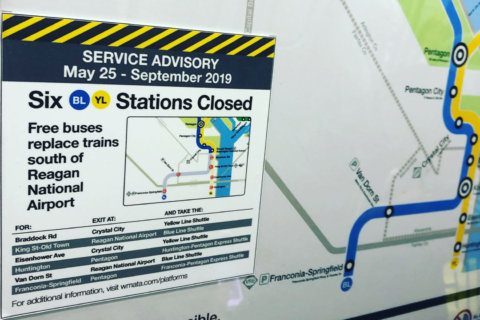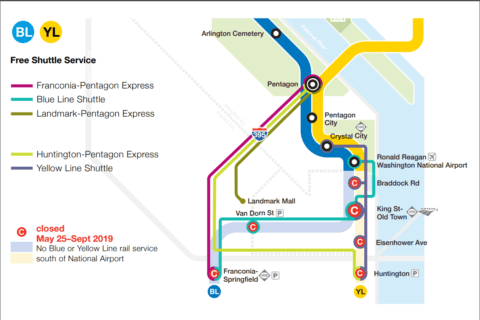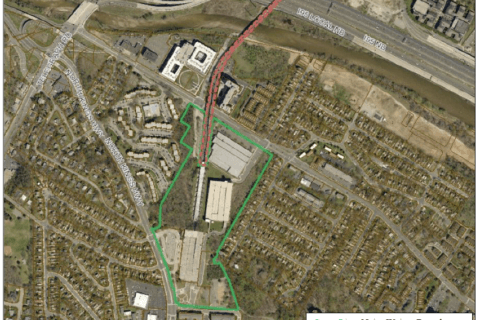Metro’s summerlong shutdown of Blue and Yellow Line stations south of Reagan National airport has significantly slowed traffic in Alexandria, Virginia.
Data from 30 traffic sensors across Route 1, Duke Street, King Street and other corridors in the city show average travel times on the road increased about 4% on average when compared to the spring, a new city report finds.
Since summer traffic is often lighter, the actual increase in delays is likely much more than that.
“The greatest increases were on eastbound Duke Street (33%) during the evening commute period and on northbound Van Dorn Street (21%) during the morning commute period,” the midsummer report said.
It mirrors past research finding that with fewer people on Metro, driving takes longer.
Read more
- Not all Metro’s ‘free’ shutdown parking is actually free
- Who has oversight of Metro shutdown construction?
- Metro’s summer shutdown means night noise for neighbors, fewer hotel stays
- New Metro union head opposes lengthy shutdowns, seeks to engage with riders
- How many people are adding to traffic during Metro shutdown?
As part of efforts to keep buses and carpoolers moving at least, Alexandria police have issued more than 200 HOV-related parking tickets and about 250 tickets to drivers who were in the HOV lane on Washington Street without enough other people in the car.
The increase in traffic on nights and weekends, along with discounts at those times on parking in city lots, has led to a 12% increase in garage use compared to the same time last year. The largest increase in use at a single lot is at the Courthouse garage on weekends.
Still, many city businesses near Metro stops have reported significant drops in revenue.
Other options helping
Traffic increases have been somewhat mitigated by thousands of people choosing not to drive alone.
Free shuttle buses are carrying about 25,000 trips each weekday and about 18,700 trips each weekend now that tweaks have been made and ridership has shifted after traffic and navigating challenges in the first week or two.
Alexandria added its own staff at stations in the city to help riders figure out where to go after Metro cut down on the number of people on the street as the shutdown went on and exact bus stop locations were moved around.
On weekdays, the busiest free shuttle route is the Franconia-Springfield to Pentagon express, with an estimated nearly 7,000 trips on average. On weekends, the Blue and Yellow Line local shuttles carry about 6,200 daily trips.
The shuttle ridership drop off on weekends is due to reduced use of the long-distance express shuttle service between the ends of the lines and Pentagon. The local shuttles are actually usually carrying more trips on weekends than on weekdays.
The Blue Line shuttle stop in Old Town at King Street and Washington Street is drawing about 370 boardings each weekday.
At Landmark Mall, about 63% of the permits issued for 400 parking spaces are being used each day. The weekday-only shuttle to Pentagon is carrying about 900 trips per day.
Many Metro riders have instead opted to take regular bus routes, though. On crowded route 11Y, ridership has nearly doubled, rising 87%.
Metroway, with its own lanes between Alexandria and Arlington, has seen ridership rise 30%. Metrobus Route 8Z is up 23%, the 21A is up 46% and the 10A is up 10% — with higher increases in the morning rush.
Overall regular DASH Bus ridership is actually down given the reduction in riders connecting from the rail system, but routes to the Pentagon have seen ridership rise about 15%.
The King Street Trolley is carrying about 175 extra trips per day, and the water taxi to and from The Wharf in D.C. is averaging 175 riders during morning commuting hours and 637 riders in afternoon commuting hours.
“Staff is evaluating the Water Taxi usage data to determine if continuing this commute option after the Metro reopens will provide a benefit to city residents and workers,” the city report said.
More people are biking too, with the number of bikes counted during the morning and afternoon rush nearly doubling on the Potomac Yard Trail and Metro Linear Trail between King Street and Braddock Road.
Alexandria plans additional DASH Bus marketing for the next few weeks, a community feedback survey after stations reopen and consideration of lessons learned that could help other parts of the region where Metro shutdowns are planned over the next few years.
The city expects to hold events to celebrate the stations reopening in September as part of regionwide efforts to encourage people to return to Metro and take public transit in general.







